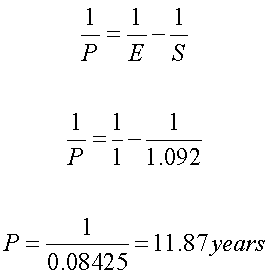One of the many tools used in Astronomy are the
formulas used to determine Orbital Motion. There are
two basic forms of
orbits:
- Sidereal Period
- Synodic Period
Sidereal period, as indicated by the accuracy of
sidereal time, is an actual measure of a complete
orbit relative to the
stars (since the
stars are
unmoving - or at least moving very slowly). A synodic period is a rotation of a
planet so that it
appears to be in the same place in the
night sky.
We have two formulas that will allow us to
determine the sidereal rotation period of the other
8
planets in our
Solar System by using the synodic
period (simply by observation).
For the
planets
Venus and
Mercury, we would use:

For
Mars,
Jupiter,
Saturn,
Uranus,
Neptune, and
Pluto we would use:

P = sidereal period in both
equations
S = synodic period in both equations
E = Earth's orbit in both equations.
Because Earth's rotation is 1 year,
E = 1 in both equations.
Here is an example, based on the
reference text:
To find the sidereal period of
Jupiter:
P = sidereal period
E = 1
S = 1.092 years (the observed synodic period)

Back to Top
|

